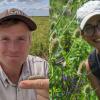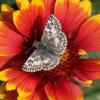Each year, the Xerces Society grants two to three Joan DeWind Awards to students who are engaged in research related to Lepidoptera conservation. Many award recipients go on to publish their research in scientific journals. You can find a list of published work below, or click to see past awardees. You can also learn more about the DeWind Award here.
Publications List
DeWind award recipient names are in bold.
Althoff, D. M., K. A. Segraves, and O. Pellmyr. 2005. Community context of an obligate mutualism: Pollinator and florivore effects on Yucca filamentosa. Ecology 86(4): 905-913.
Bucheli, S. R., and J. Wenzel. 2005. Gelechioidea (Insecta: Lepidoptera) systematics: A reexamination using combined morphology and mitochondrial DNA data. Molecular Phylogenetics and Evolution 35: 380-394.
Casas-Pinilla, L. C., C. A. Iserhard, A. Richter, K. Gawlinski, L. B. D. Cavalheiro, H. P. Romanowski, L. A. Kaminski. 2022. Different-aged Pinus afforestation does not support typical Atlantic Forest fruit-feeding butterfly assemblages. Forest Ecology and Management 518. https://doi.org/10.1016/j.foreco.2022.120279
Glaeser, R. M., and C. B. Schultz. 2014. Characterizing a contentious management tool: the effects of a grass-specific herbicide on the silvery blue butterfly. Journal of Insect Conservation 18: 1047-1058. DOI: 10.1007/s10841-014-9714-9.
Halsch, C. A., D. J. Zullo, M. L. Forister. 2023. Additive and interactive effects of anthropogenic stressors on an insect herbivore. The Royal Society B 290 (1996). https://doi.org/10.1098/rspb.2022.2431
Henry, E. H., and C. B. Schultz. 2013. A first step towards successful conservation: understanding local oviposition site selection of an imperiled butterfly, mardon skipper. Journal of Insect Conservation 17: 183-194. DOI: 10.1007/s10841-012-9496-x.
Horner-Devine, M. C., G. C. Daily, P. R. Ehrlich, and C. L. Boggs. 2003. Countryside biogeography of tropical butterflies. Conservation Biology 17(1): 168-177.
Illerbrun, K., and J. Roland. 2011. Treeline proximity alters an alpine plant-herbivore interaction. Oecologia 166: 151-159. DOI: 10.1007/s00442-010-1822-y.
Jain, A., Y. Zeng, E. L. Webb. 2021. Critical dependence of butterflies on a non-native host plant in the urban tropics. Frontiers in Ecology and Evolution 9. https://doi.org/10.3389/fevo.2021.655012
Krishnan, N., Y. Zhang, M.E. Aust, R.L. Hellmich, J.R. Coats, and S.P. Bradbury. 2021. Monarch butterfly (Danaus plexippus) life-stage risks from foliar and seed-treatment insecticides. Environmental Toxicology and Chemistry 40(6): 1761-1777. https://doi.org/10.1002/etc.5016.
Leidner, A. K., and N. M. Haddad. 2010. Natural, not urban, barriers define population structure for a coastal endemic butterfly. Conservation Genetics 11: 2311-2320. DOI: 10.1007/s10592-010-0117-5.
Leidner, A. K., and N. M. Haddad. 2011. Combining measures of dispersal to identify conservation strategies in fragmented landscapes. Conservation Biology 25(5): 1022-1031. DOI: 10.1111/j.1523-1739.2011.01720.x.
Majewska, A. A., and S. Altizer. 2019. Exposure to non-native tropical milkweed promotes reproductive development in migratory monarch butterflies. Insects 10(8): 253. Open access at https://doi.org/10.3390/insects10080253.
Majewska, A. A., S. Sims, A. Schneider, S. Altizer, and R. J. Hall. 2019. Multiple transmission routes sustain high prevalence of a virulent parasite in a butterfly host. Proceedings of the Royal Society B. Open access at https://royalsocietypublishing.org/doi/10.1098/rspb.2019.1630.
Medeiros, M. J., D. Davis, F. G. Howarth, and R. Gillespie. 2009. Evolution of cave living in Hawaiian Schrankia (Lepidoptera: Noctuidae) with description of a remarkable new cave species. Zoological Journal of the Linnean Society 156: 114-139. With 11 figures.
Mullen, S. P., E. B. Dopman, and R. G. Harrison. 2008. Hybrid zone origins, species boundaries, and the evolution of wing-pattern diversity in a polytypic species complex of North American admiral butterflies (Nymphalidae: Limenitis). Evolution 62-6: 1400-1417. Open access at https://onlinelibrary.wiley.com/doi/full/10.1111/j.1558-5646.2008.00366.x.
Nail, K.R., C. Stenoien, and K. S. Oberhauser. 2015. Immature monarch survival: Effects of site characteristics, density, and time. Annals of the Entomological Society of America 1-11 (2015); DOI: 10.1093/aesa/sav047.
Nice, C. C., Z. Gompert, M. L. Forister, and J. A. Fordyce. 2009. An unseen foe in arthropod conservation efforts: The case of Wolbachia infections in the Karner blue butterfly. Biological Conservation 142: 3137-3146.
Olaya-Arenas, P., and I. Kaplan. 2019. Quantifying pesticide exposure risk for monarch caterpillars on milkweeds bordering agricultural land. Frontiers in Ecology and Evolution 7:223. doi: 10.3389/fevo.2019.00223. Open access at https://doi.org/10.3389/fevo.2019.00223.
Oliver, J. C., and A. M. Shapiro. Genetic isolation and cryptic variation within the Lycaena xanthoides species group (Lepidoptera: Lycaenidae). Molecular Ecology 16: 4308-4320. doi: 10.1111/j.1365-294X.2007.03494.x.
Pellmyr, O., M. Balcazar-Lara, K. A. Segraves, D. M. Althoff, and R. J. Littlefield. 2008. Phylogeny of the pollinating yucca moths, with revision of Mexican species (Tegeticula and Parategeticula; Lepidoptera, Prodoxidae). Zoological Journal of the Linnean Society 152(2): 297-314. Open access at https://academic.oup.com/zoolinnean/article/152/2/297/2630856.
Prior, K. M., and J. J. Hellmann. 2010. Impact of an invasive oak gall wasp on a native butterfly: a test of plant-mediated competition. Ecology 91 (11): 3284-3293.
Riva, F., E.O. Campbell, F. Carroll, J.H. Acorn. 2019. Identification "by eye": integrative character assessment informs regional field identification of greater fritillary butterflies (Nymphalidae: Speyeria). Journal of Insect Conservation. https://doi.org/
Riva, F., J. H. Acorn, and S. E. Nielsen. 2018. Narrow anthropogenic corridors direct the movement of a generalist boreal butterfly. Biology Letters 14(2): pii: 20170770. DOI: 10.1098/rsbl.2017.0770.
Riva, F., J. H. Acorn, and S. E. Nielsen. 2018. Distribution of cranberry blue butterflies (Agriades optilete) and their responses to forest disturbance from in situ oil sands and wildfires. Diversity 10(112): 1-18. DOI:10.3390/d10040112. Open access at https://www.mdpi.com/1424-2818/10/4/112
Riva, F., J. Pinzon, J. H. Acorn, and S. E. Nielsen. 2019. Composite effects of cutlines and wildfire result in fire refuges for plants and butterflies in boreal treed peatlands. Ecosystems. https://doi.org/10.1007/s10021-019-00417-2.
Russell, C., and C. B. Schultz. 2010. Effects of grass-specific herbicides on butterflies: an experimental investigation to advance conservation efforts. Journal of Insect Conservation 14: 53-63. DOI: 10.1007/s10841-009-9224-3.
Segraves, K. A. 2003. Understanding stability in mutualisms: can extrinsic factors balance the yucca-yucca moth interaction? Ecology 84(11): 2943-2951.
Segraves, K. A., and O. Pellmyr. 2004. Testing the out-of-Florida hypothesis on the origin of cheating in the yucca-yucca moth mutualism. Evolution 58(10): 2266-2279. Open access at https://onlinelibrary.wiley.com/doi/abs/10.1111/j.0014-3820.2004.tb01602.x.
Sei, M., and A. H. Porter. 2007. Delimiting species boundaries and the conservation genetics of the endangered maritime ringlet butterfly (Coenonympha nipisiquit McDunnough). Molecular Ecology 16: 3313-3325. DOI: 10.1111/j.1365-294X.2007.03384.x.
Sherwood, J. A., D. M. Debinski, and M. J. Germino. 2011 "Testing the effects of simulated climate change effects using open sided warming chambers." University of Wyoming National Park Service Research Center Annual Report 33(21).
Sierra-Botero, L., M. Calonje, R. K. Robbins, N. Rosser, N. E. Pierce, C. López-Gallego, W. A. Valencia-Montoya. 2023. Cycad phylogeny predicts host plant use of Eumaeus butterflies. Ecology and Evolution 2023;13:e9978. https://doi.org/10.1002/ece3.9978
Slancarcova, J., A. Bartonova, M. Zapletal, M. Kotilinek, Z. F. Fric, N. Micevski, V. Kati, and M. Konvicka. 2016. Life history traits reflect changes in Mediterranean butterfly communities due to forest encroachment. PLoS ONE 11(3): e0142026. Open access at https://doi.org/10.1371/journal.pone.0152026.
Stenoien, C., K. R. Nail, and K. S. Oberhauser. 2015. Habitat productivity and temporal patterns of monarch butterfly egg densities in the Eastern United States. Annals of the Entomological Society of America 1-10 (2015); DOI: 10.1093/aesa/sav054.
Thomas, C.C., C.V. Tillberg, C.B. Schultz. 2020. Facultative mutualism increases survival of an endangered ant-tended butterfly. Journal of Insect Conservation. https://doi.org/10.1007/
Wang, Z., Y. Huang, and N. E. Pierce. 2019. Radio telemetry helps record the dispersal patterns of birdwing butterflies in mountainous habitats: Golden birdwing (Troides aeacus) as an example. Journal of Insect Conservation. https://doi.org/10.1007/s10841-019-00167-5.
Wang, Z., Y. Li, A. Jain, N.E. Pierce. 2021. Agent-based models reveal limits of mark-release-recapture estimates for the rare butterfly, Bhutanitis thaidina (Lepidoptera: Papilionidae). Insect Science. https://doi.org/10.1111/1744-7917.12949.
Wilson, A.A., B.M. Seymoure, S. Jaeger, B. Milstead, H. Payne, L. Peria, R. Vosbigian, C.D. Francis. 2021. Direct and ambient light pollution alters recruitment for a diurnal plant-pollinator system. Integrative and Comparative Biology icab010, https://doi.org/10.1093/icb/icab010.



